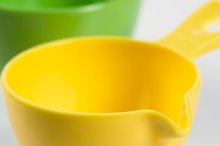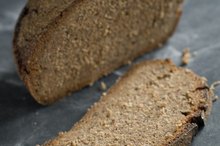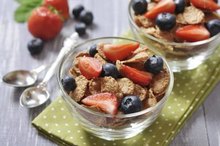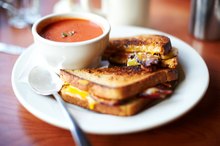How to Calculate How Many Carbohydrates Per Serving on a Nutrition Label
Carbohydrates, like protein and fat, are the nutrients from which we get energy. Sugar provides simple carbohydrates, while starch and fiber provide complex carbohydrates. The former are often considered "bad" carbohydrates, but some, such as those from fruit and dairy, are healthy. However, many simple carbohydrates and some complex carbohydrates, such as those from refined grains, cause rapid spikes and crashes in blood glucose levels. These are bad carbohydrates. Though carbohydrates have gotten a bad reputation from people advocating low-carb diets, it is the reduction of calories, and not carbohydrates, that makes a diet work. Good carbohydrates are an essential part of a healthy diet, and related information is on the nutrition label of foods.
Get between 45 and 65 percent of your daily calories from carbohydrates. Focus on getting as much as possible from the "good" carbohydrates, including those obtained from whole grains, fruit, vegetables and low-fat dairy items. In addition, aim to get at least 14 grams of fiber a day per 1,000 calories in your daily diet.
What Is the Difference Between Sugar & Carbs on Food Labels?
Learn More
Look at the top of the nutrition label on your food to ascertain the serving size. Measure the food you take with measuring cups or spoons so you know exactly how many servings you take for carbohydrate calculation purposes.
Read down past the fat, cholesterol and sodium information on the nutrition label to find the information pertaining to carbohydrate content.
How to Calculate Weight Watchers Points
Learn More
Note the total carbohydrates, which are given in grams. To the right, the label also tells you what percentage of a typical 2,000-calorie diet's recommended intake this satisfies.
Multiply the number of grams of carbohydrates per serving by the number of servings you take. For example, if 1 cup of the food provides 30 grams, and you serve yourself 1 1/2 cups, you eat 45 g of carbohydrates. If one slice of bread contains 14 g of carbohydrates, and you make a sandwich with two pieces, you get 28 g of carbohydrates from the bread alone.
Check below the total carbohydrates to see how much of it comes from fiber and how much comes from sugar. Carbohydrates from the former are good carbohydrates. Although sugar is sometimes obtained in healthy foods, limit your consumption. Multiply the fiber and sugar content by the number of servings you consume, just as with the total carbohydrates.
Tips
Get healthy carbohydrates from whole grains like oats, brown rice, wild rice, barley and popcorn. Look for foods that list a whole grain as their first ingredient. Common ones include whole wheat, whole oats, whole rye, whole corn, bulgur, buckwheat and millet. While you're reading the ingredients, check for added sugar and its simple carbohydrates. Besides sugar, brown sugar, honey and molasses, look for syrups and words ending in the "-ose" suffix.
Related Articles
References
Writer Bio
Eric Mohrman has been a freelance writer since 2007, focusing on travel, food and lifestyle stories. His creative writing is also widely published. He lives in Orlando, Florida.









